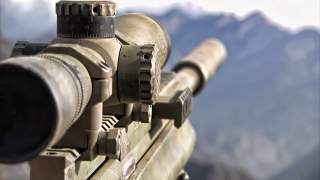Russian Snipers Can Now Kill You with Hypersonic Bullets
Faster than any comparable ammunition.
Key point: An alternative option for specific use-cases in difficult environments.
Russian weapons manufacturer Lobaev Arms has announced that they can produce small arms ammunition with a muzzle velocity of 2,000 m/s.
According to Lobaev co-cofounder Vladislav Lobaev, “we are intensely researching this topic. I think that, with a certain degree of government funding, we are in a position to produce sniper rounds traveling at 2000 meters per second within a year. That is already hypersonic speed.”
Snipers have to account for a host of external ballistics factors including wind values, elevation, and even air density to maximize accuracy. These estimations have to be made under frequently narrow time constraints and vary in complexity depending on target distance and the severity of environmental factors.
But hypersonic rounds translate into potential performance gains on several fronts. Everything else being equal, their drastically faster travel speeds would make it easier for snipers to line up their shots by minimizing the impact of external factors. Hypersonic rounds would also give the target less time to move out of the bullet’s travel path. Lobaev told a Russian defense publication that speeds over Mach 5 would “allow shots at up to 1,000 meters without any adjustments.”
At Mach 5.83 or 6,560 feet per second (FPS), Lobaev’s projected sniper round speed would be unmatched among small firearms ammunition. There are, however, technical and logistical hurdles to the mass-production of hypersonic rounds. Firing a bullet at over 6,500 fps when conventional guns struggle to exceed 4,000 fps requires extreme pressure facilitated by a reliable delivery mechanism. It is for this reason that Lobaev uses “detonating chemical components of a unique composition” over standard gunpowder. It remains to be seen what these detonating components consist of, their production cost, and the extent of their compatibility with current firearms including those in Lobaev’s own colorfully named lineup.
Moreover, noise, recoil, and weight concerns persist at the operational level. Russian special forces veteran Sergei Goncharov gave the following assessment of rifles using hypersonic ammunition in an interview with the Russian Information Agency (RIA): “the noise generated by such a weapon will give enemies the opportunity to spot the sniper; secondly, I don’t know the level of recoil and how such a weapon would be designed. If the sniper has to carry around an instrument weighing 20 kilograms, then there is no practical use for it.” Goncharov goes on state that he approaches the practicality of hypersonic small arms with a “great deal of pessimism.”
In any case, this “detonating” ammunition is almost certain to degrade firearms at a faster rate. Lobaev doesn’t deny this, instead noting that the gains from greater efficiency will offset the financial losses from added component degradation: “the lifespan of firearms using these rounds will of course be lower, but the economic effect will be greater considering their application.”
Lobaev is not positioning their hypersonic rounds as a popular replacement for traditional sniper ammunition—if nothing else, production and maintenance costs will be too great for that. Rather, they are advertising it as a cost-effective option in specific use-cases with exceedingly difficult environments or extreme ranges. Lobaev Arms is currently engaged in several ambitious projects in addition to hypersonic ammunition, namely its precision-guided firearm (PGF) system and what it calls the world’s first self-loading sniper rifle. In this context, hypersonic ammunition research is a part of Lobaev’s effort to aggressively bet on fledgling technologies that they believe will capture large shares of the arms market in the coming decades.
Mark Episkopos is a frequent contributor to The National Interest and serves as a research assistant at the Center for the National Interest. Mark is also a Ph.D. student in History at American University. This article first appeared earlier this year.

